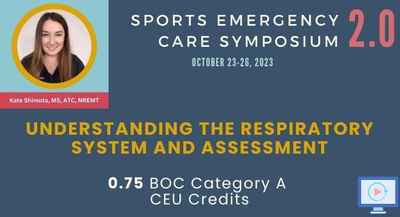General Course Information
Learning Material
Course Info (BOC Domains of Athletic Training; Presentation Description; Learning Objectives; Clinical Practice Gap Statement; Clinical Bottom Line; Summary Conclusions)
BOC Domains of Athletic Training:
- Domain II - Examination, Assessment and Diagnosis
- Domain Ill - Critical Incident Management
Presentation Description:
In this presentation, we delve deep into the intricacies of the respiratory system. We'll start by comprehensively understanding its structure and function. You'll learn to identify common assessment findings in individuals with normal breathing, helping you establish a baseline for evaluation. We'll explore the crucial link between dyspnea and hypoxia, enhancing your ability to detect early signs of respiratory distress. Additionally, we'll discuss how various prehospital medical conditions can lead to inadequate oxygenation, emphasizing the importance of prompt recognition and intervention.
Learning Objectives:
- Explore the structure and function of the respiratory system.
- Recognize common assessment findings in patients exhibiting normal breathing.
- Investigate the connection between dyspnea and hypoxia.
- Examine how prevalent prehospital medical conditions can result in insufficient oxygenation.
Clinical Practice Gap Statement:
There is a noticeable deficit in the proficiency of athletic trainers in accurately assessing the respiratory system during sports events. This gap in understanding how to distinguish between normal and abnormal respiratory patterns, or recognizing the linkage between dyspnea and hypoxia, can contribute to delayed or inadequate responses. This lapse can result in severe repercussions, including endangering athletes' health. Bridging this knowledge gap is paramount for optimal athlete care.
Clinical Bottom Line Statement:
The competency in understanding and assessing the respiratory system is a cornerstone in sports emergency care. A well-timed and accurate assessment can avert critical health incidents. This presentation serves as an educational vehicle to fortify athletic trainers with the necessary skills to evaluate respiratory conditions effectively and act promptly. The acquired skills will significantly contribute to the safeguarding of athlete health and safety.
Summary Conclusion Statements:
- Proficiency in assessing the respiratory system is indispensable for athletic trainers.
- Quick identification of dyspnea and hypoxia can be life-saving in athletic emergencies.
- Being aware of how certain prehospital conditions affect oxygenation is crucial for effective intervention.


